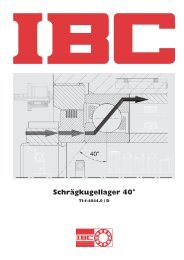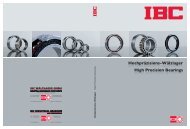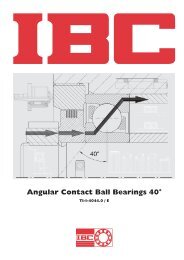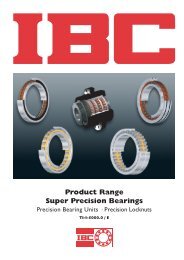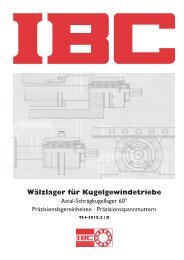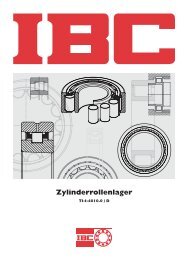IBC Rolling Bearings With Atcoat Coating
IBC Rolling Bearings With Atcoat Coating
IBC Rolling Bearings With Atcoat Coating
You also want an ePaper? Increase the reach of your titles
YUMPU automatically turns print PDFs into web optimized ePapers that Google loves.
<strong>IBC</strong> <strong>Rolling</strong> <strong>Bearings</strong><br />
<strong>With</strong> ATCoat <strong>Coating</strong><br />
TI-I-5011.2 /E
<strong>IBC</strong> <strong>Rolling</strong> <strong>Bearings</strong> and Linear Guidance Systems<br />
<strong>With</strong> ATCoat <strong>Coating</strong><br />
The solution to exceptional challenges<br />
Avariety of processes and new materials have been developed<br />
in recent years that are designed to meet the demanding<br />
and extremely varied technical and commercial needs of<br />
today.And the material surface of rolling bearings and linear<br />
components is becoming more and more important for the<br />
overall performance and reliability of machines, units and<br />
equipment. However, outside influences very often alter the<br />
surface quality of materials or corrode the surface material.<br />
Awhole range of advantages can be achieved by coating the<br />
material surface of rolling bearings and linear components.<br />
However, many coating processes are not suitable for<br />
situations in which rolling or compressive stress occurs.<br />
ATCoat thin densechromium coating for rolling bearings is<br />
aprocess developedjointly by <strong>IBC</strong> WälzlagerGmbH and<br />
ATCArmoloy Technology <strong>Coating</strong>s GmbH &Co. KG. The<br />
coating is available in arange of specifications, depending<br />
on the basic material that is used and the intended application.<br />
Since this type of coating results in extremely good<br />
rolling capacity,especially if used on rolling bearings, it<br />
provides very good protection against wear and corrosion.<br />
ATCoat protects the surface from outside environmental<br />
conditions and thereby increasesthe service life of rolling<br />
bearings and linear components and the life time of machines<br />
and units.<br />
2<br />
The considerable technicalimprovement involvedinthis<br />
process also leadstoenergysavings and an efficient use<br />
of material.Any steelsuitable for rolling bearings may<br />
be used as the basicmaterial to be coated, e.g. 100Cr6<br />
(1.3505) steel. <strong>Coating</strong> is also very beneficial if you use<br />
AISI 440C (1.4125) corrosion resistantsteelorAISIM50<br />
(1.3551). The ATCoat process permits the combination of a<br />
toughbasicmaterial with afirmlyadhering,very thin chromium<br />
coat.This is why,compared to bearings of the same<br />
size, thosewith an ATCoat coating offer higher resistance<br />
to wear and corrosion and therefore lead to alonger life<br />
time.
The ATCoat coating consists of 98% pure chrome. The<br />
chromium coating is extremelyhard, cone-shaped, precise,<br />
very thin,elastic and highly pure. It can be deposited<br />
by ahigh-energy process for any steelthat is suitable for<br />
coating. Because the process temperature is below80°C<br />
there is no structural change to the basicmaterial,and<br />
the coated rolling bearings and linear components retain<br />
theirdimensional stability.The ATCoat surface hardness is<br />
between 75 and 78 HRC (1300–1560HV).<br />
Surface of the ATCoat coating<br />
Die Erfahrung hat gezeigt, dass mit einerdeutlichen Ver-<br />
Cross section ofthe ATCoat coating<br />
Experience has shown that the expected service life is<br />
considerably longer if this coating is used. If the intended<br />
application allows for such processing, the raceways may<br />
be further processedwith the Hyper Surf Finish technology<br />
developedby<strong>IBC</strong>. Especially if used with ceramic rolling<br />
elements made of Si 3N 4,the coating permits asignificant<br />
increase in speed of up to 40%. Fretting corrosion that<br />
may form on floating bearings, aphenomenon that occurs<br />
due to the micro displacement of the rings of the bearing<br />
during thermal expansion or vibration, is also avoided. In<br />
many cases this leads to asignificantly longer and troublefree<br />
operating of units. The result is along-lasting loose<br />
bearing fit as well as easier disassembly if the bearing<br />
needs to be replaced.<br />
Because of the special surface topography,the emergency<br />
run properties of the bearings are substantially improved.<br />
Should the lubrication system fail for instance, the units<br />
are still able to run under part load for acertain period of<br />
time; they can also be shut down properly.This means that<br />
secondary damage can be limited or avoided altogether.<br />
3
<strong>IBC</strong> rolling bearings with ATCoat coating are therefore<br />
often used in unfavourable lubrication conditions.<br />
Such unfavourable conditions exist<br />
for example:<br />
■ if lubrication may only be effected withlow-viscosity<br />
mediathatdonot produce aseparative lubrication film;<br />
■ if very lowrotational speeds occur that do not allow an<br />
elasto-hydrodynamic lubrication film to develop;<br />
■ if oscillating movements, e.g. swivelling, without achieving<br />
afull revolution occur,and aseparative lubrication<br />
film cannot be maintained at the reversal points;<br />
■ if sliding occurs in unloaded rolling bearings;<br />
■ if, during fast accelerations or decelerations, smearing<br />
occurs when bearing rolling elements slide due to the<br />
force of continuance that is caused by mass inertia in<br />
conjunction with an inadequate preload.<br />
The two diagrams below demonstrate the benefits of the<br />
ATCoat coating, with high precision angular contact ball<br />
bearings takenasanexample.<br />
4<br />
High precision angular contact ball bearings<br />
Fig. 1 Fig. 2<br />
standard type<br />
coated inner and outer ring<br />
coated inner and outer ring with<br />
ceramic rolling elements<br />
Less friction leads to alower temperature and therefore a<br />
better rolling coefficient for high precision angular contact<br />
ball bearings with ATCoat coating (see Fig. 1). There are<br />
many differenttypesofapplication: <strong>IBC</strong> rolling bearings<br />
and linear components with ATCoat coating have been<br />
used successfully in the aerospace industry,inplant<br />
engineering for the food,pharmaceuticaland chemical<br />
industries, in high-performance unit engineering as well as<br />
in offshore technology.Areas of application include vacuum<br />
technology,liquid gas pumps, pumpswith insufficient<br />
lubrication, and gas turbines. The ATCoat coating technology<br />
has also been used successfully in turbo-chargers,<br />
construction machines,shaker screens, machine toolsand<br />
ballscrews.<br />
Thesebenefits are illustrated below, with high precision<br />
angular contact ball bearings used in machine toolsasan<br />
example. The permissible rotationalspeedofhigh precision<br />
angular contact ball bearings is closely linked to other<br />
parameterslike preload, friction, operating and ambient<br />
temperature, lubrication, materials, and installation conditions.<br />
These factors interact and are decisive in determining<br />
the life time of abearing.<br />
Rotational speed for oil/air lubrication<br />
standard type<br />
increased rotational speed due to alarger<br />
number of smaller rolling elements<br />
coated inner and outer ring<br />
coated inner and outer ring with<br />
ceramic rolling elements
Fig. 2depicts ways of successfully increasing rotational<br />
speed. The coating leads to significant technical improvement<br />
in this respect.<br />
Resistance to corrosion<br />
The ATCoat coating is especially suitable for protecting<br />
steelagainst corrosion.<strong>Rolling</strong> bearings and linear components<br />
coated with an ATCoat coating can be used as an<br />
alternative to bearings and components made of corrosion<br />
resistantsteel. The ATCoat coating exhibits acorrosionbehaviour<br />
that is similar to corrosion resistantsteel, especially<br />
with regardtothe functional surfaces.<strong>Rolling</strong> bearings and<br />
linear components that have an improved surface due to<br />
theirATCoat coating are protected against water,steam,<br />
caustic solutionsand, to alimited extent, acids. Carrying<br />
out asalt spraytest illustrates the very good results<br />
that the ATCoat coating achieves for corrosion protection.<br />
<strong>With</strong>inthe spaceofonly 24 hours,95% of the surface of an<br />
uncoated standard bearing has succumbed to corrosion.<br />
In comparison, corrosion extends to approx. 25% of the<br />
surface of abearing made of corrosion resistantsteel, but<br />
an ATCoat coated bearing has acorroded surface area of<br />
only 1%. The test is carried out according to ASTM B117<br />
and largely conforms to DIN 50 021.<br />
The roughness of the surfaces is asignificant factor in<br />
protecting against corrosion. The most effective protection<br />
against corrosion can therefore be carried out on the<br />
raceway of the bearing rings.<br />
How toincrease rotational speeds<br />
ATCoat coated high precision angular contact ball bearings<br />
lead to a lowertemperature because there is less friction;<br />
they therefore have an improved rolling resistance.<br />
<strong>Coating</strong> the raceway of arolling bearing enables higher<br />
rotational speeds and alonger service life at lower operatingtemperatures.<br />
The use of ceramic rolling elements<br />
made of Si 3N 4 leads to further improvements because of<br />
the reduced rotating mass of such elements.<br />
5
<strong>IBC</strong> <strong>Rolling</strong> <strong>Bearings</strong> and Linear Guidance Systems<br />
<strong>With</strong> ATCoat <strong>Coating</strong><br />
Increased life time<br />
Recent technical improvements in steel production and in<br />
rolling bearing manufacture have led to areduction in the<br />
“traditional” causes of failure due to material fatigue. While<br />
wear to the surface increasingly occurs through metal parts<br />
coming into contact with each other,failure may also be<br />
caused by bearings whose rotating speed is too slow,because<br />
the lubricant film that separates the contact surfaces<br />
may be breached if the bearing does not maintain sufficient<br />
speed. Another cause of failure is an excessively high<br />
operating temperature. To avoid such failures, the surface<br />
should be improved with regard to as many factors as possible.<br />
The result should be asurface topography that has a<br />
cone-shaped surface structure. This improves the running<br />
surface of the bearings and leads to the best possible<br />
performance and an increased life time. Where insufficient<br />
lubrication exists or unfavourable operating conditions apply,only<br />
an improved surface will enable better emergency<br />
run properties to be achieved.<br />
Tolerances, bearing clearance, dimensions<br />
and precision<br />
The ideal coating for rolling bearings is between 2–4<br />
µmthick, and the dimensional tolerance for surfaces<br />
and chamfers is approx. ±1μmfor such athin coating.<br />
This means that the ATCoat coating does not affect the<br />
dimensional accuracy. Therefore, rolling bearings of the<br />
highest precision grades may be coated. <strong>Rolling</strong> bearings<br />
with small dimensionsshould be checked for apossible<br />
change in fit.<br />
Coatedrolling bearings are manufactured by <strong>IBC</strong> in their<br />
factory withinthe upperhalf of the radial bearing clearance<br />
class, e.g.:<br />
CN ➾ CNH<br />
C3 ➾ C3H<br />
It is not advisabletodisassemble and coat abearing once<br />
it has been manufactured.<br />
6<br />
Surface finish and coefficient of friction<br />
Depending on the pre-existing roughness, there may<br />
be aslight increase in the mean roughness R a.IfR ais<br />
between 0.02 μm and 0.05 μm, an increase to between<br />
0.05 μm and 0.07 μm is possible. Such an increase<br />
can, however, bereduced again byemploying the HSF<br />
(Hyper Surf Finish) process developed by<strong>IBC</strong>. This<br />
process only smooths the upper part of the cone-shaped<br />
structure, according to the various areas of application<br />
and purposes.The very good rolling characteristics of<br />
the ATCoat coating lead to an improvement in the friction<br />
coefficients.The friction coefficient that applies to friction<br />
between two ATC chromium coatings is up to 50% lower<br />
than the coefficient for two steel surfaces.The following<br />
values are applicable for lightly oiled fitting surfaces:<br />
Friction partner Static friction<br />
(dry) µ 0<br />
Operating temperature<br />
The hardness of the ATCoat coating rangesbetween 75<br />
and 78 HRC (1300–1560HV), and the coating is neutral<br />
in atemperature range between approx. –230 °C and<br />
+800 °C, without any major changes occurring to adhesion<br />
or structure. The usable range of operating temperatures<br />
largely depends on the materials used for the<br />
rolling bearings, e.g. basic materials, cage materials, seal<br />
materials or lubricants.<br />
Elasticity and contact pressure<br />
Sliding friction<br />
(dry) µ<br />
steel/steel 0.25 0.18<br />
steel/ATCoat 0.17 0.15<br />
ATCoat/ATCoat 0.14 0.12<br />
The ATCoat coating has outstanding adhesivequalitiesdue<br />
to its specific molecular bond.The coating has extremely<br />
high elasticity,due to the composition of its electrolytes.<br />
Even when heavystatic loadsorspecific contact pressures<br />
are applied, the coating does not flakeoff.<br />
Conformity and standards<br />
ATCoat thin densechromium complies with many standards<br />
and specifications. It has been tested and approved<br />
according to AMS 2438 A, AMS QQ-C-320, AMS 2406 G<br />
and MIL-STDas well as according to many DSV company
specifications. Independentstudies have shown that the<br />
ATCoat coating is neither toxicnor does it causeskin<br />
reactions. AccordingtoEURegulationNo. 1935/2004, the<br />
ATCoat coating may come into direct contact with food.<br />
Operating efficiency<br />
The ATCoat coating is the efficient solutiontomany problems.Itprotects<br />
surfaces from environmentalinfluences<br />
and thereby increasesthe life time of rolling bearings and<br />
linear components as well as of machines and units. This<br />
is asignificant technicaladvance and is an effective way<br />
of saving on materialsand energy. The ATCoat coating<br />
leadstoincreasedproductionreliability as well as to<br />
reductionsinmachine shutdown and, as aconsequence,<br />
to lower maintenance costs.<br />
Functions of the ATCoat coating<br />
■ reduction of friction<br />
■ better adhesive strength of the lubrication film<br />
■ separation of materials of the same type<br />
■ prevention or reduction of cold welding caused by<br />
adhesion<br />
■ reduction of the formation of fretting corrosion<br />
■ the sliding properties of arolling bearing ring with<br />
regard to the shaft or the housing are ensured<br />
(important for floating bearings)<br />
■ outward corrosion protection andextensive chemical<br />
resistance to aggressive materials or tribooxidation<br />
■ wear protection due to increasedhardness of the<br />
coating: 72–78 HRC (1300–1560 HV)<br />
Prefix of ATCoat coated rolling bearings<br />
AC- ATCoat rings<br />
ACC- ATCoat rings+Si 3N 4rolling elements<br />
Suffix of ATCoat coated rolling bearings<br />
A11 coated inner and outer ring<br />
A15 coated inner and outer ring, corrosion resistant<br />
rolling elementsand cage<br />
A21 coated inner ring<br />
A31 coated outer ring<br />
Please note:<br />
<strong>IBC</strong> Wälzlager GmbH<br />
Test specimen:<br />
Measuring point:<br />
Inspector:<br />
Date:<br />
R a<br />
R t<br />
R zDIN<br />
Horizontal scale:<br />
Horizontal magnification:<br />
Vertical scale:<br />
Vertical magnification:<br />
Reproducing this brochure (including reproduction in extracts)isonly permittedwith<br />
our consent.The purpose of the information containedinthis publication is to present<br />
the products.The information in this brochure describes the products based on today’s<br />
knowledge,but not in each case does it describewarranted characteristics.The<br />
information containedherein is not able to take account of every possibleoperating condition<br />
that the ATCArmoloy coating may be subject to. Please contactusifexceptional<br />
operating conditions or operational demandsoccur,e.g. if chemical agents or other<br />
aggressive media interact with the coating. We cannot assume liability with regard to<br />
possible errors or missing information, neither can we assume liability for damage that<br />
may occur directly or indirectly due to the use of the information contained herein. We<br />
reserve the right to implement changes to the technical specifications in the course of<br />
product design.<br />
© Copyright <strong>IBC</strong> Wälzlager GmbH 2011<br />
0.0120 µm<br />
0.13 µm<br />
0.08 µm<br />
Measurement: R/10x0,08/G/32<br />
Form type:<br />
LS Radius<br />
Length:<br />
0.80 mm<br />
Area of measurement: 1mm<br />
+1.000 µm<br />
+0.800 µm<br />
+0.600 µm<br />
+0.400 µm<br />
+0.200 µm<br />
-0.000 µm<br />
-0.200 µm<br />
-0.400 µm<br />
-0.600 µm<br />
-0.800 µm<br />
-1.000 µm<br />
Taylor Hobson<br />
Talysurf plus<br />
IR 71906<br />
Raceway laterally – roughness<br />
rom<br />
20-05-2011<br />
50 µm per unit<br />
200x<br />
0.20 µm per unit<br />
50000x<br />
+1.000 µm<br />
+0.800 µm<br />
+0.600 µm<br />
+0.400 µm<br />
+0.200 µm<br />
-0.000 µm<br />
-0.200 µm<br />
-0.400 µm<br />
-0.600 µm<br />
-0.800 µm<br />
-1.000 µm<br />
7
Tel: +49/64 41/95 53-02<br />
Fax: +49/64 41/5 30 15<br />
P.O. Box 1825 ·35528 WETZLAR (GERMANY)<br />
Industriegebiet Oberbiel<br />
35606 Solms-Oberbiel<br />
Germany<br />
e-mail: ibc@ibc-waelzlager.com http://www.ibc-waelzlager.com<br />
<strong>IBC</strong> INDUSTRIAL BEARINGS<br />
AND COMPONENTS AG<br />
Tel: +41/32/6 52 83 53<br />
Fax: +41/32/6 52 83 58<br />
Gibelstrasse 43<br />
2540 Grenchen<br />
Switzerland<br />
e-mail: ibc@ibcag.ch http://www.ibc-waelzlager.com



